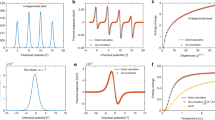Abstract
We have applied the Numerical Renormalization Group method to study a mesoscopic system consisting of two samples of a metal separated by an insulating barrier with nanometer dimensions. It allows the tunnelling of a single electron from one side to the other side of the junction. The junction is represented by a generalized orthodox model, which considers the electronic scattering interaction due to the hole and the tunnelling electrons, localized in the source and in the drain electrode, respectively. We have calculated the static properties (charge transfer, charge average, quadractic charge average and specific heat) and the electric conductivity of the junction for the model parameters given by the tunneling matrix element t, the barrier energy U = e 2/2C (where C is the capacitance of the system) and by the electronic scattering potentials V L(R) acting on the electrons of the left(right) electrode.
Similar content being viewed by others
References
D.V. Averin, K.K. Likharev, Mesoscopic Phenomena in Solids, edited by B.L. Altshuler, P.A. Lee, R. Webb (Elsevier, Amsterdam, 1991)
H. Grabert, M.H. Devoret, Single Charge tunnelling – Coulomb Blockade Phenomena in Nanostructures (Plenum Press. N.Y., 1992)
M.A. Kastner, Rev. Mod. Phys. 64, 849 (1992)
K. Flensberg, M. Jonson, Phys. Rev. B 43, 7586 (1991)
H.O. Frota, K. Flensberg, Phys. Rev. B 46, 15207 (1992)
F. Guinea, M. Ueda, Phys. Rev. B 49, 5722 (1994)
M. Ueda, F. Guinea, Z. Phys. B: Condens. Matter 85, 413 (1991)
S. Drewes, S.R. Renn, F. Guinea, Phys. Rev. Lett. 80, 1046 (1998)
M. Ueda, S. Kurihara, Phys. Rev. B 46, 12568 (1992)
K.G. Wilson, Rev. Mod. Phys. 47, 773 (1975)
H.R. Krishna-murthy, J.W. Wilkins, K.G. Wilson, Phys. Rev. B 21, 1003 (1980)
H.R. Krishna-murthy, J.W. Wilkins, K.G. Wilson, Phys. Rev. B 21, 1044 (1980)
H.O. Frota, L.N. Oliveira, Phys. Rev. B (RC) 33, 7871 (1986)
G.D. Mahan, Phys. Rev. 153, 882 (1967)
G.D. Mahan, Phys. Rev. 163, 612 (1967)
S. Gasiorowicz, Quantum Physics (John Wilei & Sons, Inc.. N. Y., 1974)
M. Yoshida, A.C. Seridonio, L.N. Oliveira, Phys. Rev. B 80, 235317 (2009)
Author information
Authors and Affiliations
Corresponding author
Rights and permissions
About this article
Cite this article
Frota, H.O., Pinto, J.W.M. Tunneling in mesoscopic junctions using the numerical renormalization group method. Eur. Phys. J. B 81, 215–224 (2011). https://doi.org/10.1140/epjb/e2011-20046-9
Received:
Revised:
Published:
Issue Date:
DOI: https://doi.org/10.1140/epjb/e2011-20046-9




